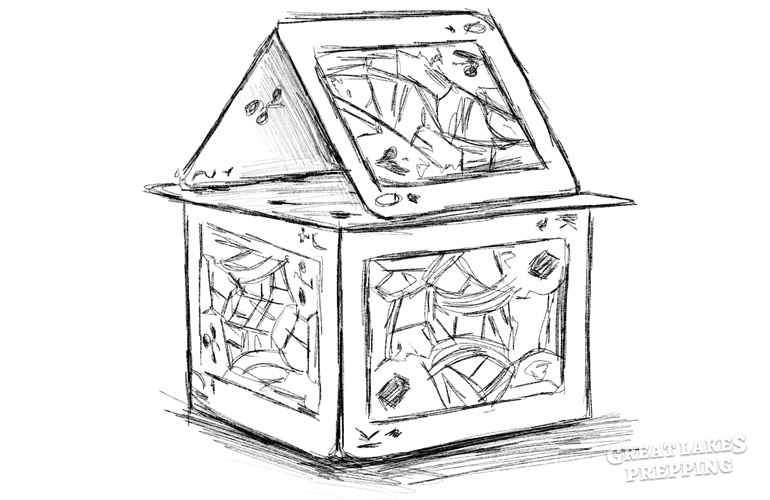Introduction: Prepping for a Long-Term Collapse

- Preface:
- Prepping for a Long-Term Collapse
- Chapter 1:
- Survival Community Overview
The unprepared are a predictable bunch, and most people fall into this category. What starts with civil unrest and rioting will end with panic and starvation. Some folks’ “best case scenario” will involve refugee camps and food lines. For most, the reality will be much grimmer. When the populated urban centers have become cesspools of death, disease, and human waste, the only salvation for those stranded within will be for death to come swiftly.
For those who are prepared and are truly dedicated to surviving, their outlook is much brighter. Life is about priorities and choices. For most, social media and reality television are among the top day-to-day priorities. For the average American, going out of town on vacation or saving up for a larger television are “long-term objectives”. For a very tenacious few, getting prepared for the “what if” that is looming over our society’s head is a continuous priority, and having a plan in place to continue living should the worst happen is the ultimate long-term objective.
The Blackout of 2003
When one single part of our system goes down for even a couple days, we observe a frightening indication of how bad things could quickly become if some or all parts of our system were to shut down indefinitely. In 2003, the Northeastern United States and parts of Canada experienced a large-scale failure of the power grid. Among the many states and provinces which were affected by this power grid failure were several densely-populated cities including New York City, NY, Cleveland, OH, Detroit, MI, and Toronto, ON (just to name a few). In all, an estimated 55 million people were without power for between one and three days.
The frightening effects of this power failure started immediately. Traffic signals didn’t work, so there was gridlock on every street and highway. The few gas stations with backup generators which were able to remain open had lines of cars a mile long waiting to fill up their tanks (which also led to incredible price gouging and sky-high tension between citizens). So the majority of people could not purchase gasoline for transportation or for their personal generators. Oil refineries were forced to shut down temporarily, which exacerbated the disruption of gasoline supplies that were experienced in the coming weeks.
No restaurants were open. No grocery stores were open. I located one crusty convenience store near my home which was still selling items for cash. I stocked up on a few bags of chips and candy bars, as it was pretty much the only food they had.
Cities which rely heavily on public transit were even more affected. Commuters were trapped in stalled subway cars. Passenger trains were not operating. Airports essentially shut down because of the electrical equipment needed for just about every aspect of operation.
Mobile phone communication was crippled, due to power loss at cellular sites. People were unable to get in touch with family and friends to find out if they were safe. The loss of electrical power led to a multi-faceted breakdown of most modern conveniences and municipal services.
During the first day, spirits were not particularly low in my neighborhood. For the people who were not stuck somewhere in unrelenting traffic, there was almost a festive atmosphere. As it was summer, folks were grilling up all of the meat in their fridges before it went bad. People up and down the neighborhoods were holding impromptu block parties and barbecues. However, by the second day the mood began to quickly change. There was no more unspoiled meat to grill up. Most areas still had water service to some degree, though it was advised that tap water be boiled before consuming.
There were no street lights. The demand for police assistance around the cities was far too great for local law enforcement agencies to keep up on. By the beginning of night #2, groups of people were roaming the streets. I’m not sure if they were simply bored, or if they were looking to improve their situation by worsening the situation of others. I chose not to approach them to ask. Rioting and looting was reported in some areas. People felt helpless, and fear and desperation were already beginning to creep in. It had only been two days since this one common utility went down. One single cog in our modern clockwork of infrastructure, and it was only two days before society in several large metropolitan areas came dreadfully close to unraveling. This was the experience which first opened my eyes to the frailty of our system on which most of our very lives depend.
What Are We Preparing for?
If you are reading this, then chances are strong that you’ve previously considered the possibility that life as we know it could abruptly change due to some circumstance outside of our control. There are millions of people in the United States who identify as “preppers” or “survivalists.” The reasons behind why these people feel it necessary to diligently prepare are a vast array of theories and speculation. Many citizens worry that our fragile power grid or other utilities will fail on a grand scale, causing the food supply and every other piece of infrastructure to subsequently grind to a halt. Some believe that a nuclear war will erupt between The United States and another world superpower. Others believe climate change will spur a series of cataclysmic natural disasters. Many of those concerned for the future of civilization abide by the notion that inevitable global financial collapse will lead to our currency being worthless, ultimately sparking civil unrest and spiraling out of control into a complete societal meltdown. A fair number of preppers are afraid that a new civil war will break out between the United States government and its citizens.
Regardless of which global, national, or regional incident leads to the breakdown of our modern way of life, the outcome is bound to be, more or less, the same. When people can’t afford or otherwise can’t access the resources they need, panic and desperation ensue. When panic and desperation ensue, violence is sure to follow. If everybody worked together for the greater good, the outcome would still be questionable because of how many people will be in need of resources. But people don’t tend to work together in times of prolonged crisis. Those who respect life the least are bound to take advantage of those who are weaker, both mentally and physically. People will kill and steal over a can of food or a drink of water. Others will kill simply because there are no legal consequences. Mothers, fathers, sons, and daughters will become killers – either in defending against evil people or because they, themselves are desperate for resources.
Looting, vandalism, death, destruction, and rape will be commonplace. And it will not take very long after the system crashes for this reality to foment. In August of 2005, Hurricane Katrina caused unimaginable destruction to Louisiana and Mississippi. Much of New Orleans was under water, millions of people were without electricity, and help was slow to arrive. Some people were stranded in (or on) their homes for a long time. Within a day after the hurricane moved on from New Orleans, the violence and crime began. Incidents of looting, robbery, car-jacking, murder, and rape were rampant. While some claimed that they took only food from stores, the rest of the country watched on the evening news as looters trudged through floodwaters, holding freshly plundered flat-screen televisions over their heads.
Those who weren’t doomed to remain trapped within the flooded wreckage were taken to refugee camps. Hundreds of thousands of people who evacuated their homes were kept in makeshift facilities around neighboring states. The Red Cross and National Guard brought in what supplies they could. This was life for the lucky. Food and water lines, sleeping on cots or the floor, and waiting in line to use a toilet were the luxuries they enjoyed. Packed together like a crawling pile of humanity, these were the “lucky ones” who relied on being saved by the government during a time of crisis.
This was one localized region in the United States. Every other part of the country was perfectly intact and capable of sending aid and supplies to the affected region. Legions of law enforcement personnel, construction workers, and all manner of aid workers flocked to Louisiana and Mississippi in the aftermath of Hurricane Katrina to help with the recovery efforts. But what if every region in the United States is in trouble? What if there are too many people for the government to rescue? What if the “rescue” is more horrible than what you’re being rescued from?
The vast majority of Americans rely on the efforts of thousands of machines, computers, and other people just to live their day-to-day lives. From our utilities, to access to our money, to getting something to eat for lunch, we are at the mercy of a massively intricate and interwoven web of services and infrastructure. It’s unsettling and inconvenient to think about, but every one of the systems and processes that make up this delicate web of modern life are startlingly fragile and vulnerable. It would take less than most people like to believe for everything to spiral out of control. All it takes is for a couple of services to stop working on a large scale, and before you know it there will be pandemonium.
And those who are responsible for our services and supply chains, even parts that aren’t necessarily initially affected, are just regular people. They will become part of the dissolution, just like everybody else. When fear takes hold, the guy who is scheduled to deliver a truck full of groceries to your supermarket will not be a truck driver on that day. He will be a husband, father, son, or simply a scared individual. When panic ensues, the people in charge of keeping your mobile phone service and internet up and running will no longer be technicians who give a damn about your service. They will be mothers, sisters, brothers, uncles, or simply frantic human beings. These folks will be concerned about themselves and their families – not you and yours. Your need for groceries and internet can go to hell. What do you do for a living? Will you go to work the day that half of America loses electricity? If the grocery store shelves are baron and panic is spreading through the streets, will you be heading into the office to catch up on your spreadsheets? The point I’m trying to thoroughly drive home is that our modern way of life is supported by a house of cards that has been built in tornado alley.
This is why we prep. If “the shit hits the fan,” no matter what that means to you, are you willing to risk the safety and lives of yourself and your family to a government agency that may or may not even be able to help? Are you going to sit around and fall victim to the desperation, violence, and destruction happening all around you? If you are reading this, then chances are probably strong that you already consider it preferable to be in charge of your own fate, should the shit hit the proverbial fan.
What if it’s Only Temporary?
Throughout our nation’s history, every disaster that has led to widespread panic, hunger, homelessness, and absence of civil services has been a temporary situation. The United States has experienced disasters which caused people’s lives to be disrupted for days, weeks, or months. But in each case, people end up tightening their belts, pulling up their bootstraps, and getting the problem sorted out. Short of a full-scale catastrophe or chain reaction of infrastructure failures, most disaster scenarios are not likely to indefinitely change the face of this country as we know it. So far, this country has survived and rebuilt after plenty of natural disasters, utility service failures, and civil unrest.
If something disrupts the supply chain, infrastructure, or societal foundation and is likely to be a temporary circumstance, then sheltering in place is a viable course of action. If you have prepped all you will need for several months, and your place of shelter can physically withstand the circumstances, it is entirely possible that you can outlast an incident which is ultimately fixable.
For example, if the power grid goes down in your area for several months but it’s being actively repaired, you can survive. If there was a natural disaster that disrupted the food supply to your town, but your home is unscathed, you can hunker down and ride it out. Your biggest concern will be security at that point, because most people who will be affected even temporarily will soon become desperate. Think about how much food is in your pantry right now. Most households in the United States don’t have more than a few days’ worth of food at any given time. It won’t be too long before most families have depleted even the last old can of lima beans from their cupboard. FEMA and Red Cross water trucks, food lines, and the National Guard will become the way of life for most people in the area until everything is restored to normal. Just looking at photos of displaced people and refugees after Hurricane Katrina is enough to make me want to be able to take care of myself in the aftermath of something like that. If you have stored food, water, supplies, and security measures in your home, and your home is still a viable place to remain after an event that causes a disruption in services, you will be in a much better position than most. This is where your stores of dried foods, water, and supplies come in. As long as you can keep others from taking what you have, you can ride it out and wait until order and services are restored. Canned food, water barrels, and firewood will keep you going nicely — but only until they run out. I believe most people who engage in “prepping” are equipped to survive a scenario of completely independent living for no more than a few months.
However, if your entire state or country is undergoing a scenario in which you will likely be without the supply chain or social order, it’s going to be very serious. The United States is resilient. It craves order and normalcy. No matter how big of a disaster, we’ve always bounced back. Most disasters are somewhat localized. Hurricanes, earthquakes, tornadoes, terrorist attacks, and rioting are events that occur in relatively isolated locations (in the grand scheme of things). The recovery and rebuilding initiatives happen quickly and with a lot of resources. Federal aid, state aid, and the assistance from surrounding cities and even other countries make for a somewhat speedy recovery of services. We will clean, repair, rebuild, and resupply everything in an impressive amount of time, as long as we are able to do so.
But imagine an event or scenario where this was unable to happen. Such an event would have to be so big or far-reaching that the entire country, region, or world is also affected. If everybody needs help, there is nobody available to help. If this is the case, and an incident or chain of events took place that brought down the entire country’s social structure and supply chain, then what we’re really talking about at this point is a total collapse of society. If this happens, nothing in our lifetimes will likely ever be the same. If it does go back to anything resembling “normal”, it’s going to take a very long time. Police officers, soldiers, medical professionals, sanitation workers, farmers, and everybody in between who are responsible for keeping our civilization running will no longer be people of those professions. They will be fathers, mothers, husbands, wives, brothers, and sisters who are now worried about the very survival of their families and themselves.
What I’m getting at is if a disaster or event takes place which is sure to be temporary, then sheltering in place at your home is plausible. But if something takes place that is bound to leave society broken down for greater than several months, then it’s a safe bet that society will be broken down for a lot longer than several months. And if you are left on your own in a true WROL/SHTF scenario for an indefinite amount of time, it’s a very bad idea to stay anywhere near a heavily populated urban or suburban environment.
To recap: For a short-term survival situation where rule of law, the supply chain, and infrastructure will almost certainly be restored in the foreseeable future, you may be fine to shelter in place at your home if you are equipped and capable of doing so. But if we’re talking about a long-term survival situation where the very fabric of our civilization has crumbled, you’d better get as far away from the hordes of starving, thirsty, lawless, unprepared people as you can. How do you prepare for this sort of situation? How will you survive and thrive after getting the hell out of town?
There are a lot of publications about emergency preparedness, homesteading, food storage/preservation, and everything in between. What this text aims to present is a road map for how to go about planning and establishing a “survival community,” which I believe provides the best chances and outlook for surviving the long-term after a collapse of what we currently recognize as society.
This article is part of a series of excerpts from the book, “Prepper Community”. All excerpts are used with explicit and exclusive permission granted by the author and publisher to GreatLakesPrepping.com.

